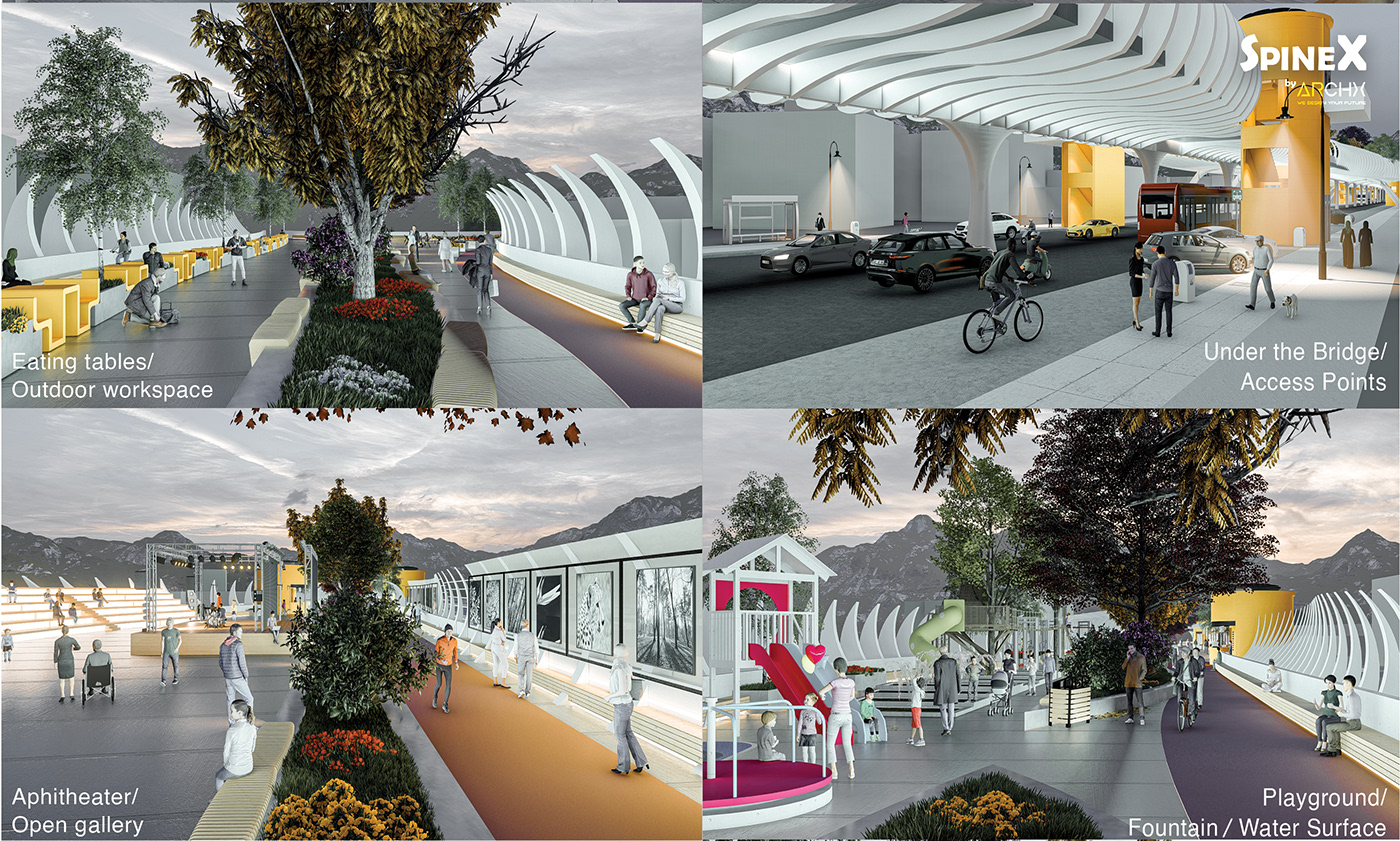SpineX
Project Year: 2023
Authors: Natali Veleska, Alen Cvetkovski, Dona Mitrovska
Location: Nikola Karev boulevard ("Plasticharska Street"), Skopje, North Macedonia
Software Used: Rhinoceros, Grasshopper, Sketch up, Lumion, Auto Cad 2D, Adobe Photoshop, Adobe Illustrator
The SpineX project is an architectural response to the challenge set by the competition "Skopje for the New Generation," organized by Europe House Skopje, where it was awarded the third prize.
Publications from the award winning event:
https://trn.mk/europe-house-go-proslavi-chetvrtiot-rodenden-so-arhitektonski-konkurs
https://marh.mk/izlozba-skopje-na-novata-generacija/
https://a1on.mk/culture/arhitektonska-izlozhba-skopje-na-novata-generacija/
https://www.porta3.mk/poznati-dobitnicite-na-nagradite-na-konkursot-skopje-na-novata-generacija-foto/
https://www.slobodnaevropa.mk/a/skopje-na-novata-generacija
https://sdk.mk/index.php/kultura/tsentralnata-poshta-s-ushte-nema-pokriv-a-ushte-od-2021-e-na-listata-7-najzagrozeni-spomenitsi-vo-evropa
https://trn.mk/europe-house-go-proslavi-chetvrtiot-rodenden-so-arhitektonski-konkurs
https://marh.mk/izlozba-skopje-na-novata-generacija/
https://a1on.mk/culture/arhitektonska-izlozhba-skopje-na-novata-generacija/
https://www.porta3.mk/poznati-dobitnicite-na-nagradite-na-konkursot-skopje-na-novata-generacija-foto/
https://www.slobodnaevropa.mk/a/skopje-na-novata-generacija
https://sdk.mk/index.php/kultura/tsentralnata-poshta-s-ushte-nema-pokriv-a-ushte-od-2021-e-na-listata-7-najzagrozeni-spomenitsi-vo-evropa

The street known as "Plasticarska" (bul. Nikola Karev), one of the proposed locations for the competition, was an evident priority candidate for improvement according to our team. The street is a place with unsafe traffic, despite the high frequency of people and vehicles; a place with a forgotten identity, despite its rich historical and local context; an example of a concrete jungle where the only "greenery" is plastic Christmas trees in stores; and a place of urban chaos, inaccessible to everyone, where no rules are respected despite its good location in the city and being one of the gates to the city.

The main goal was to address these issues through a recognizable and imposing structure that would give a new upgraded identity (without suppressing the past) to Skopje, our Skopje for the new generation. Accordingly, we structured the challenge we set for ourselves into the following aspects:
Safety: Addressing traffic chaos and unmarked pedestrian crossings by providing safe crossing points and separating vehicle and pedestrian infrastructure.
Mobility: Creating a new, safe, and dedicated infrastructure for pedestrians and cyclists to reduce traffic congestion.
Social and local context: Bringing back the spirit of the old "Dukjandjik" and connecting programmatically with the Old Bazaar by forming a market for handmade goods. Enriching the space with cultural content for all generations (open gallery, open stage), recreational spaces (a park for children and adults), public spaces for socialization, and street food.
Accessibility: Providing equal opportunities for people with disabilities through ramps, elevators, and toilets.
Sustainability: Creating a green belt and water surfaces to reduce the temperature of the location and provide a source of green energy. Ensuring attractive spaces for the place to live.
Flexibility and adaptability: Designing the concept to easily adapt to a part of the street or expand further. Not disrupting the existing built structure and infrastructure.

Thus, SpineX emerged, a pedestrian and cycling bridge at an elevated level, stretching along the entire "Plasticarska," a new favorite place in the city - primarily a safe passage accessible to all, rich in urban content, vibrant public spaces, the old spirit of the artisan Dukandjik, and greenery. It does not disrupt traffic and commercial flow or parking on the lower level.
The composition of SpineX is the result of four generative elements through which all the aforementioned challenges are addressed:
1. Spine (Construction):
The primary structure of large concrete columns (1x0.5m) placed at a distance of 20m and a central prestressed beam in the longitudinal direction supports the secondary structure of prefabricated concrete ribs placed at a distance of 2m. The ribs are designed parametrically (parameters: length, width, and main curve) and are different from each other, depending on the need to be open (stage) or rolled (roof) for the program in that part. This structure can be extended or shortened as needed due to its segmentation.

2. Towers (Access and Supply Points):
The yellow towers have three functions: access (housing stairs and elevators), supply (solar panels on the roof), and commercial (various points for street food). Three of the towers also have a sanitary function, with the central toilet for people with special needs. The towers are strategically placed at the most frequent unmarked crossing points that we documented to represent a safe alternative. The entire bridge is powered by the solar panels on top of the towers.

3. Strips:
As the main functional elements: the pedestrian path, the bicycle path, and the green strip are placed along the bridge. The strips are then interwoven to create a picturesque experience of space. The green strip is along the central axis to reduce tension in the construction.
4. Zones:
After placing the main strips along the bridge, spatial extensions were designed to accommodate the intended program. The extensions are located over parts of the street where there is enough space not to be encroaching on the already built and over state-owned parcels. There are two dining and socialization zones at both ends of the strip, a recreation zone (fountain and playground), an artistic zone (stage and gallery), and a shopping zone (handmade craft bazaar).



Gallery from night of the award ceremony:












